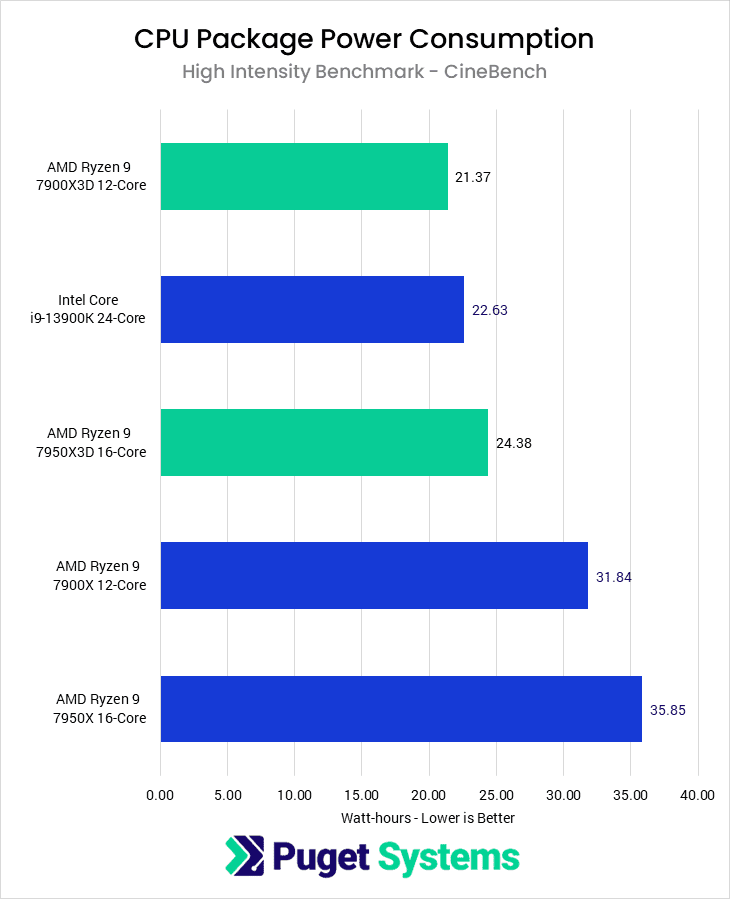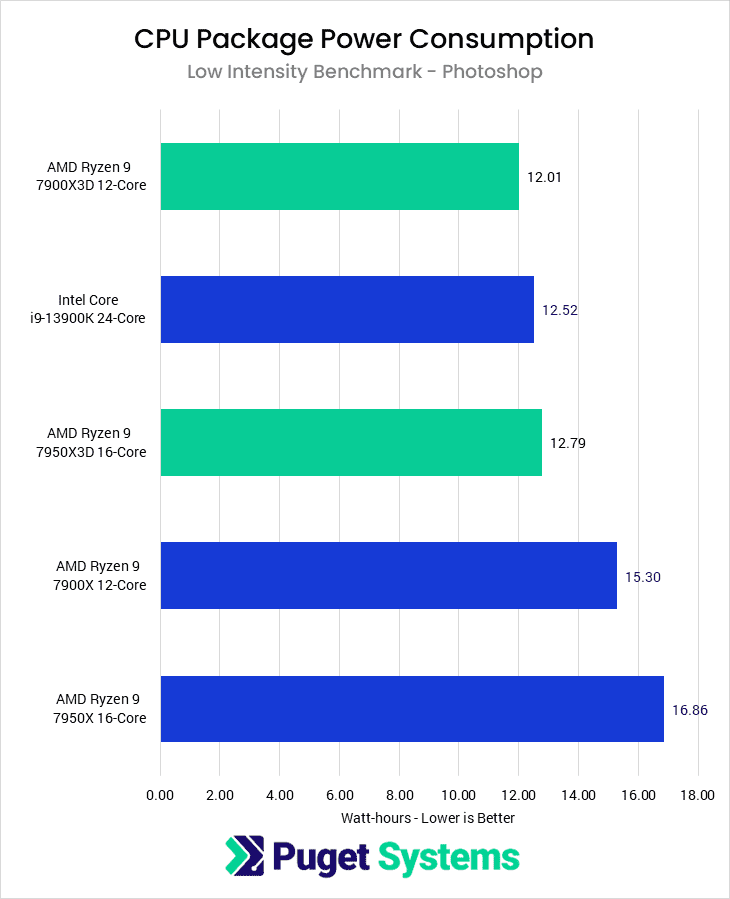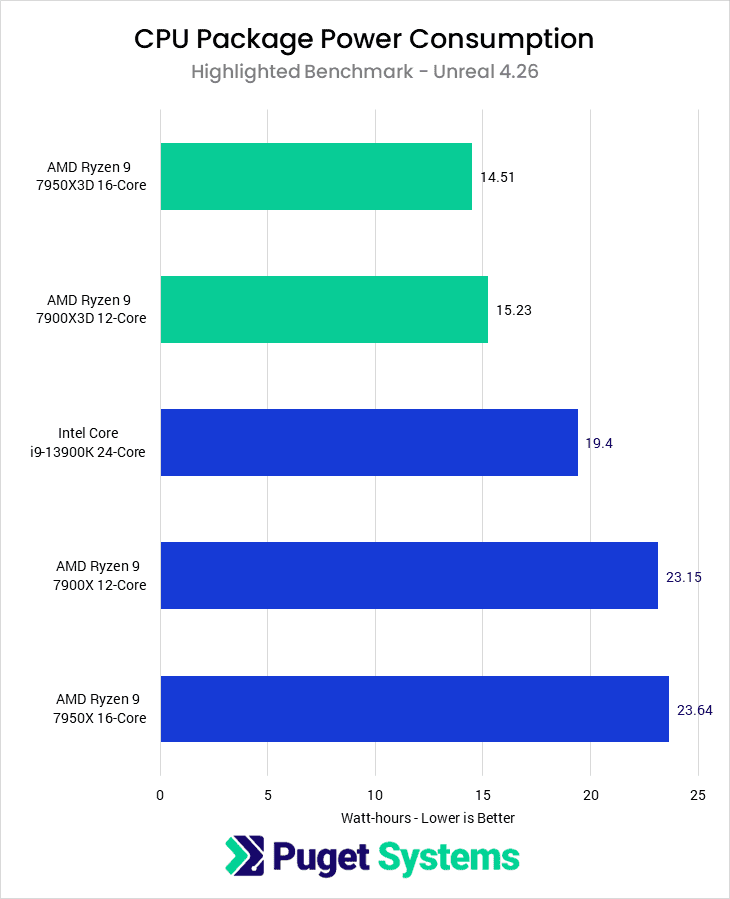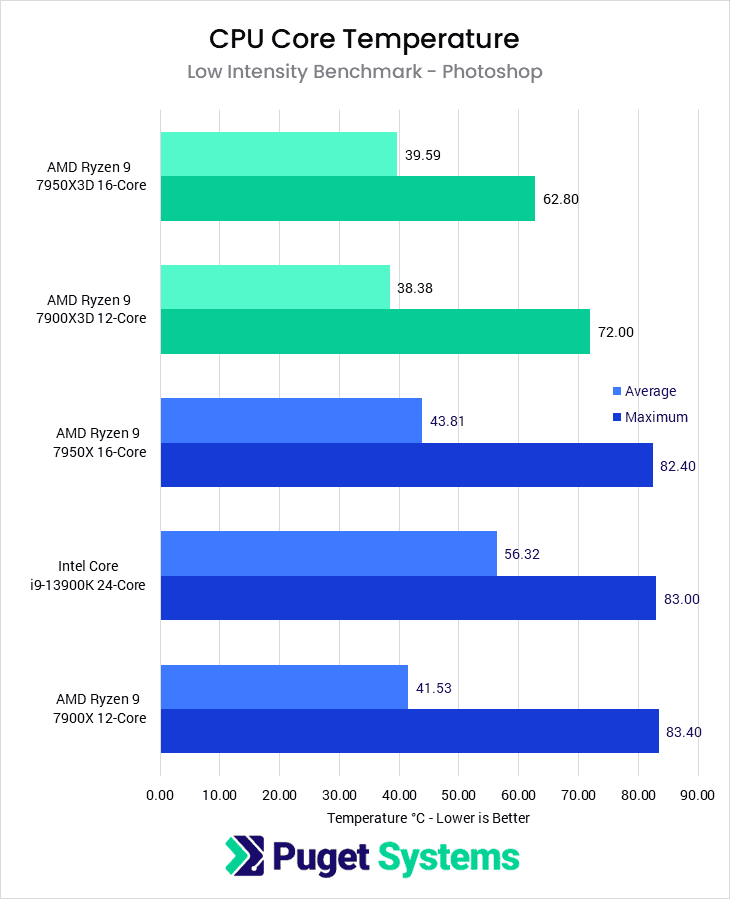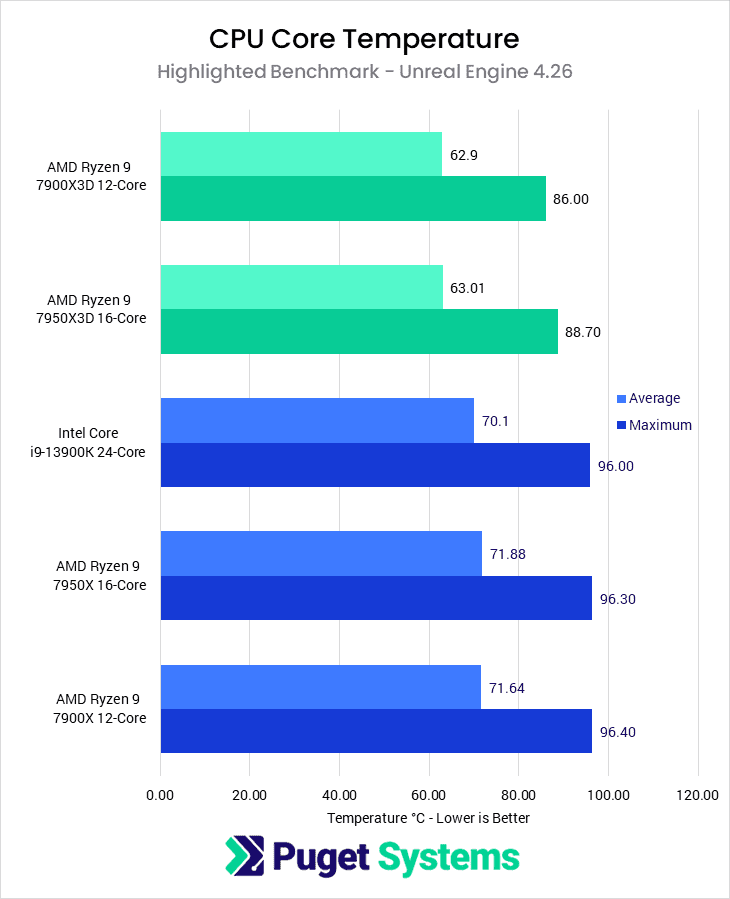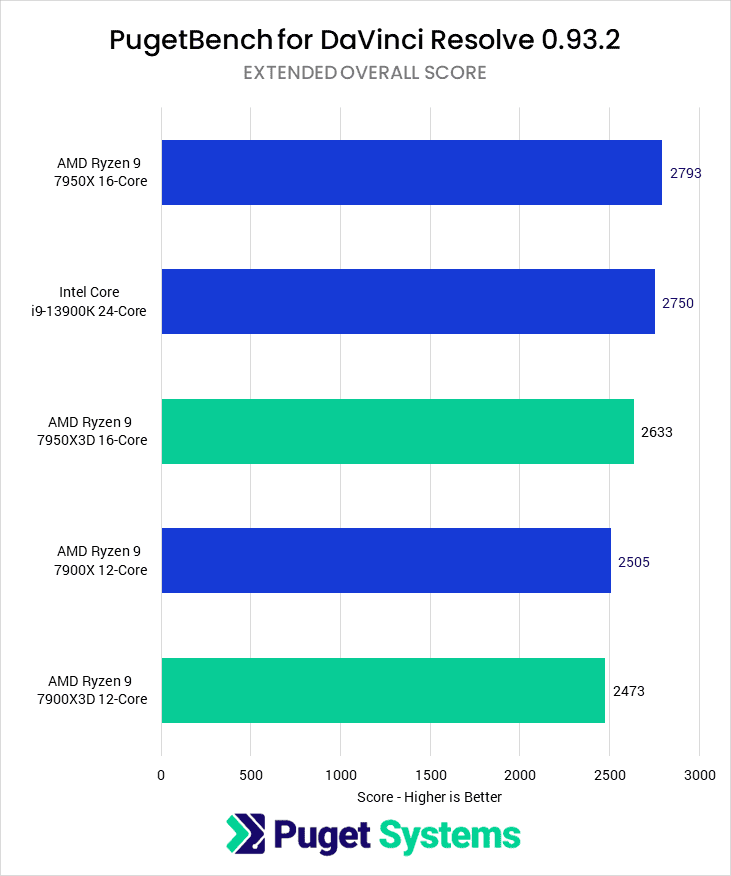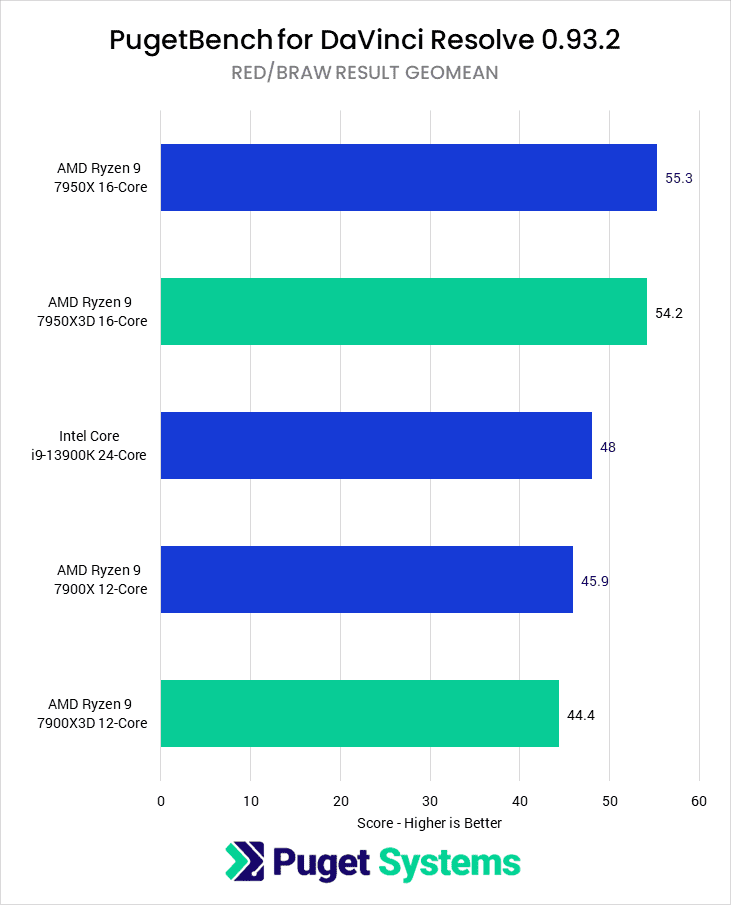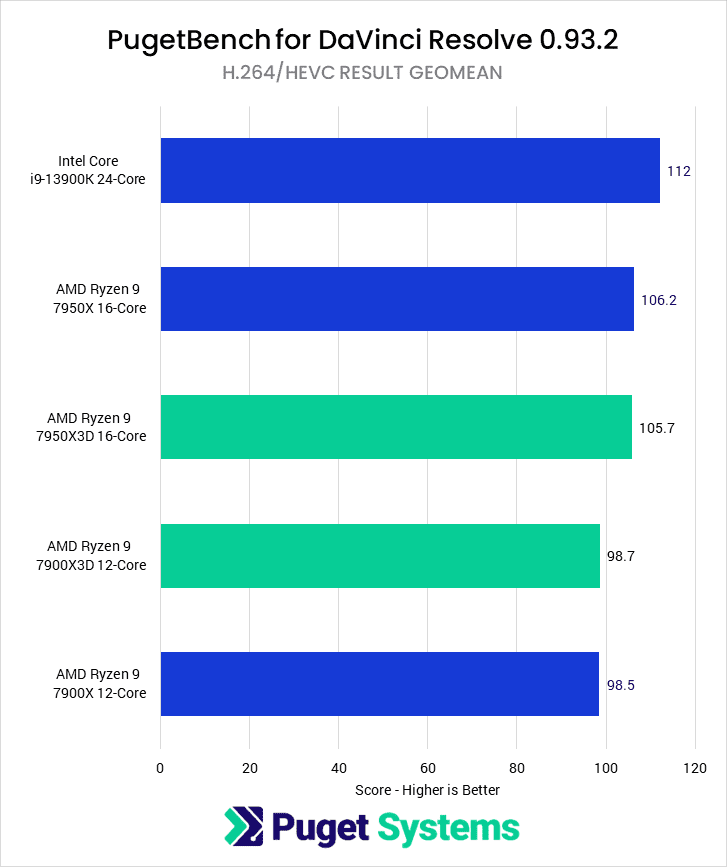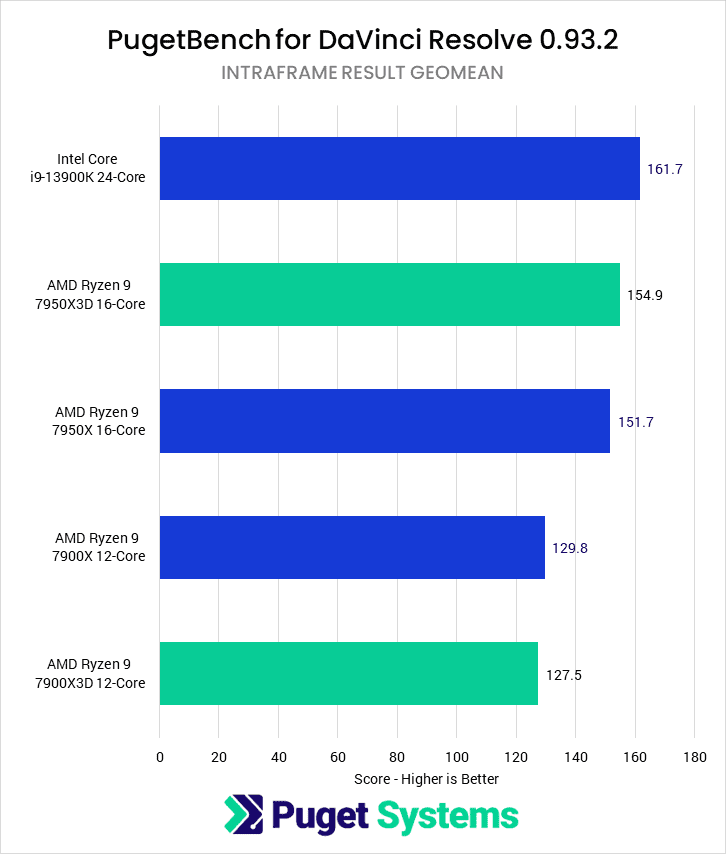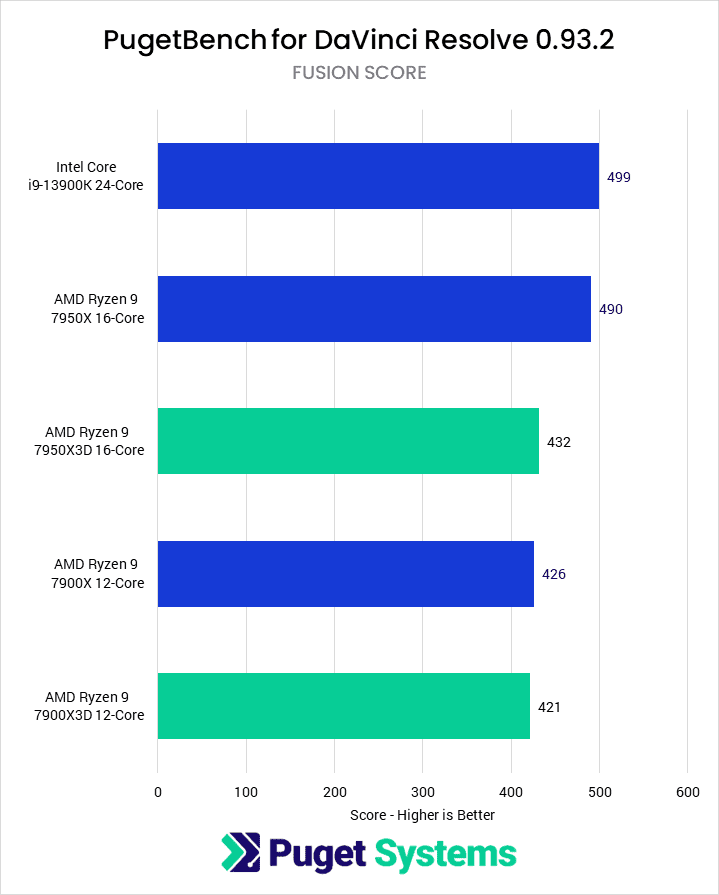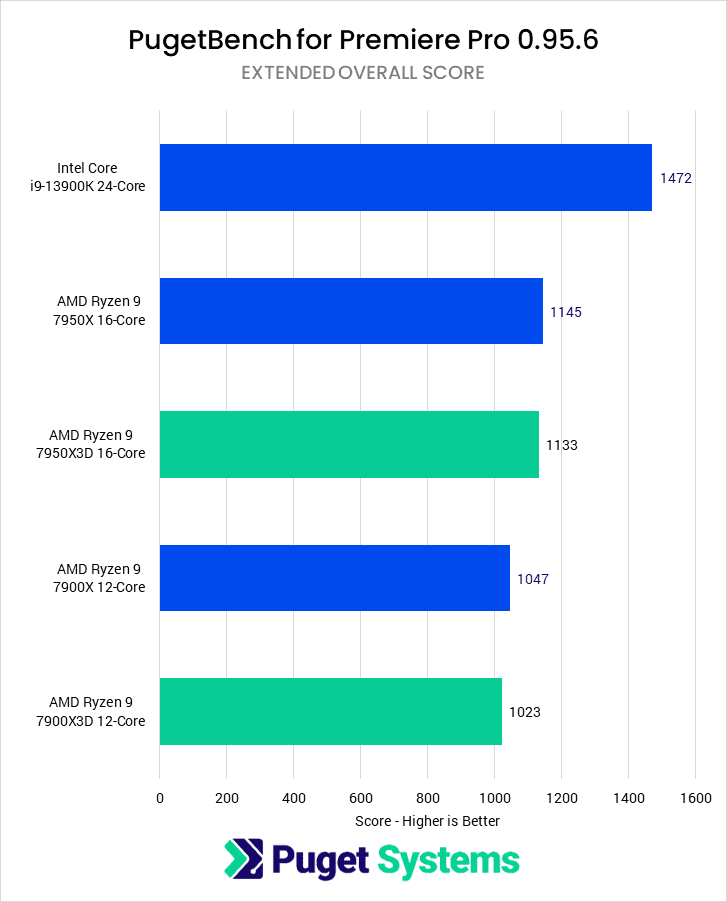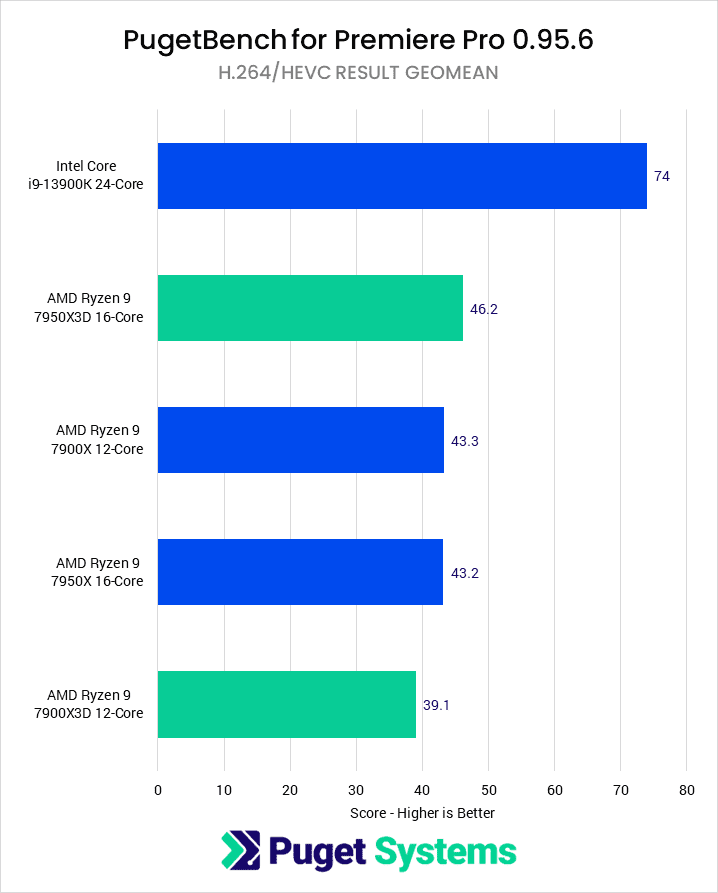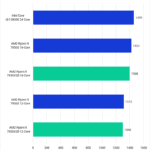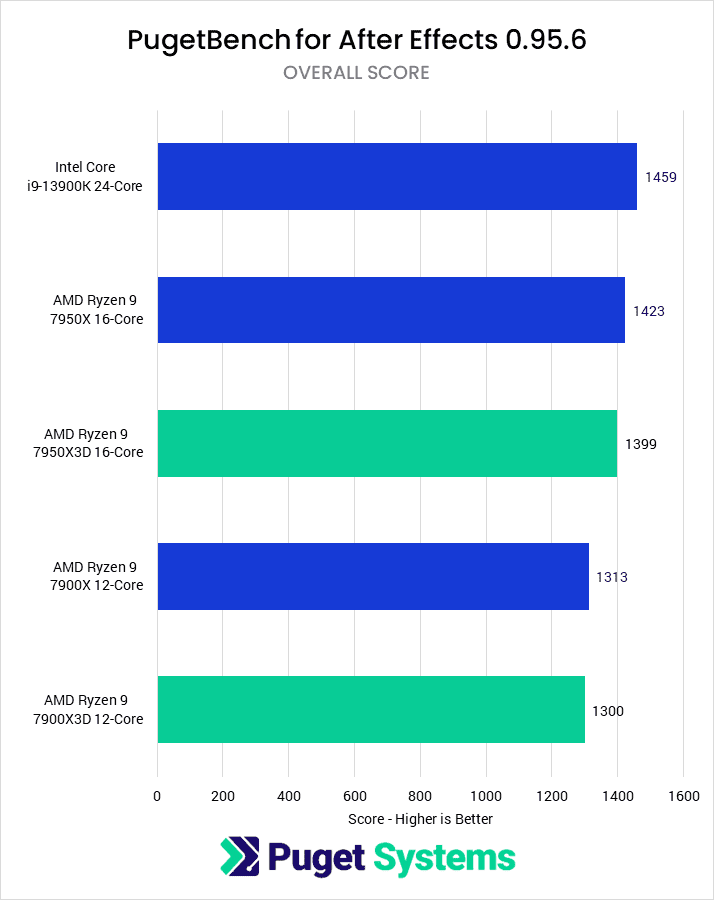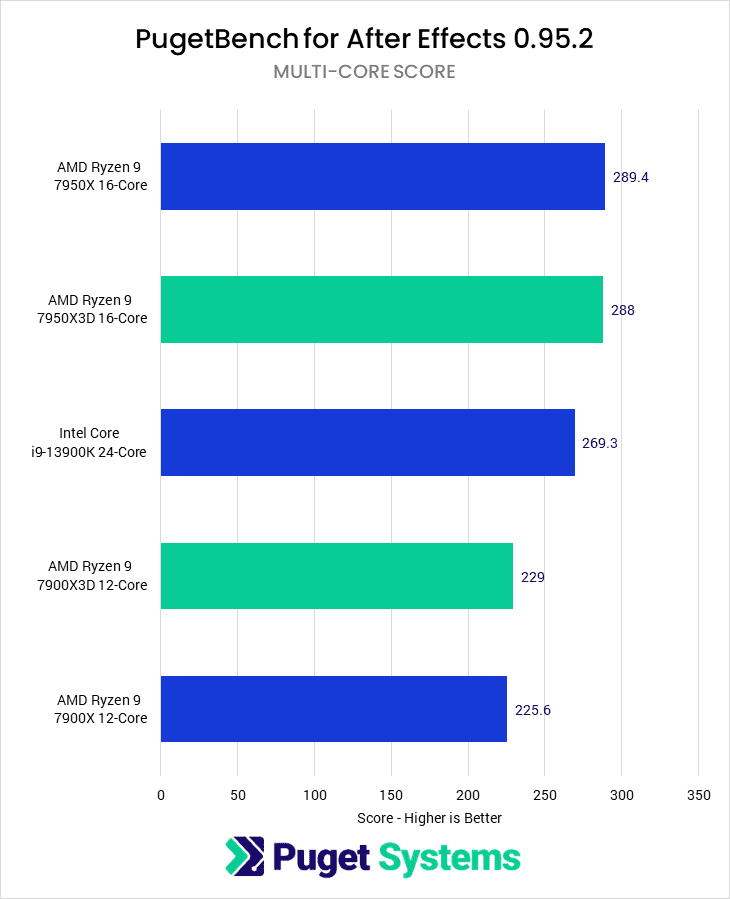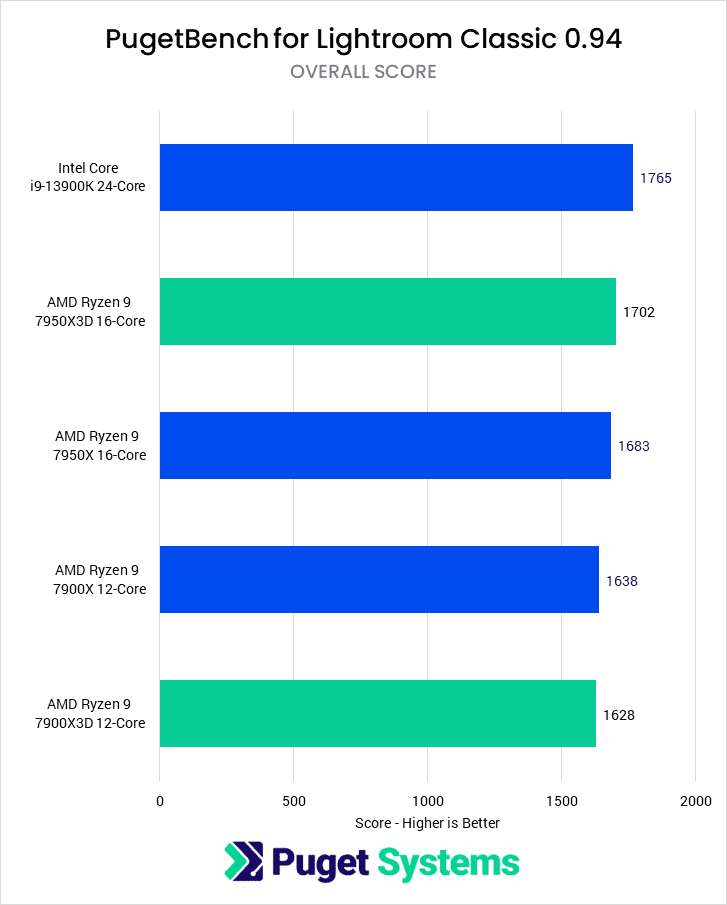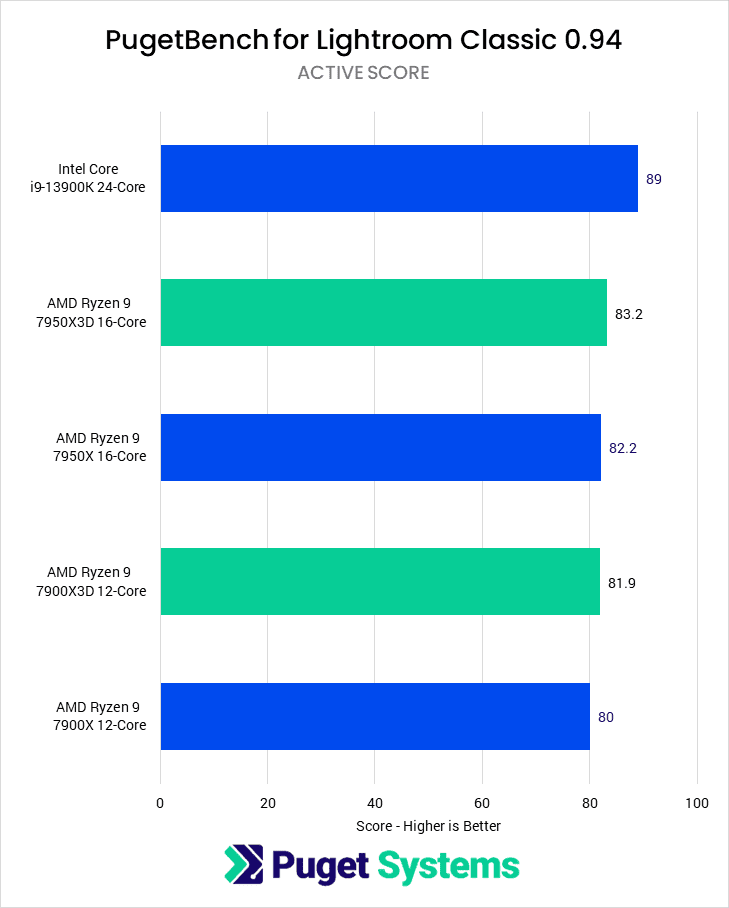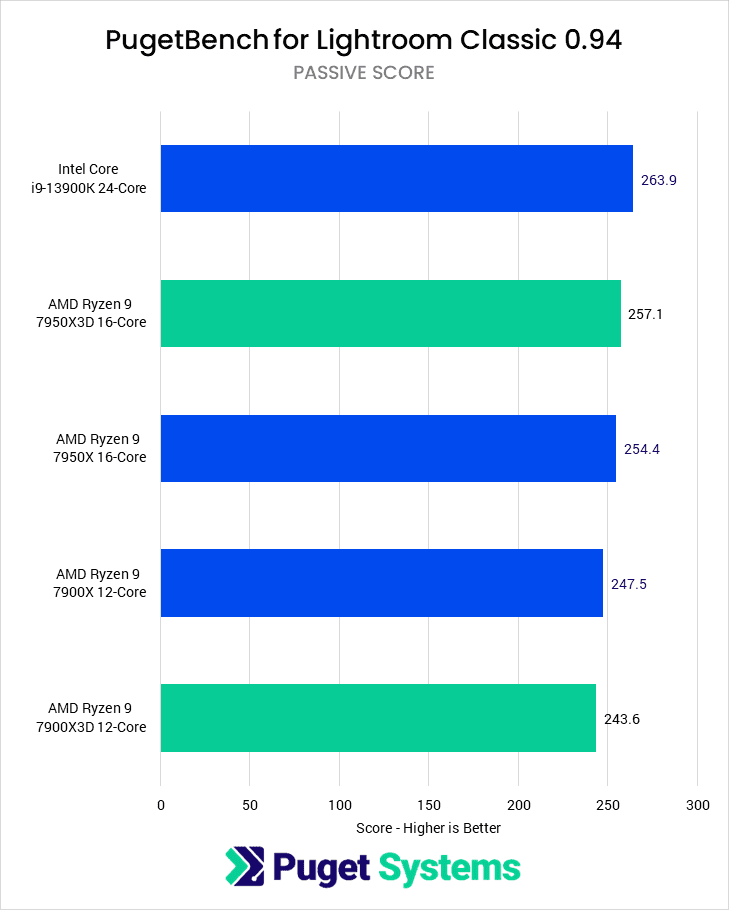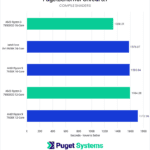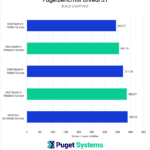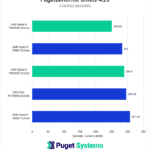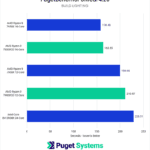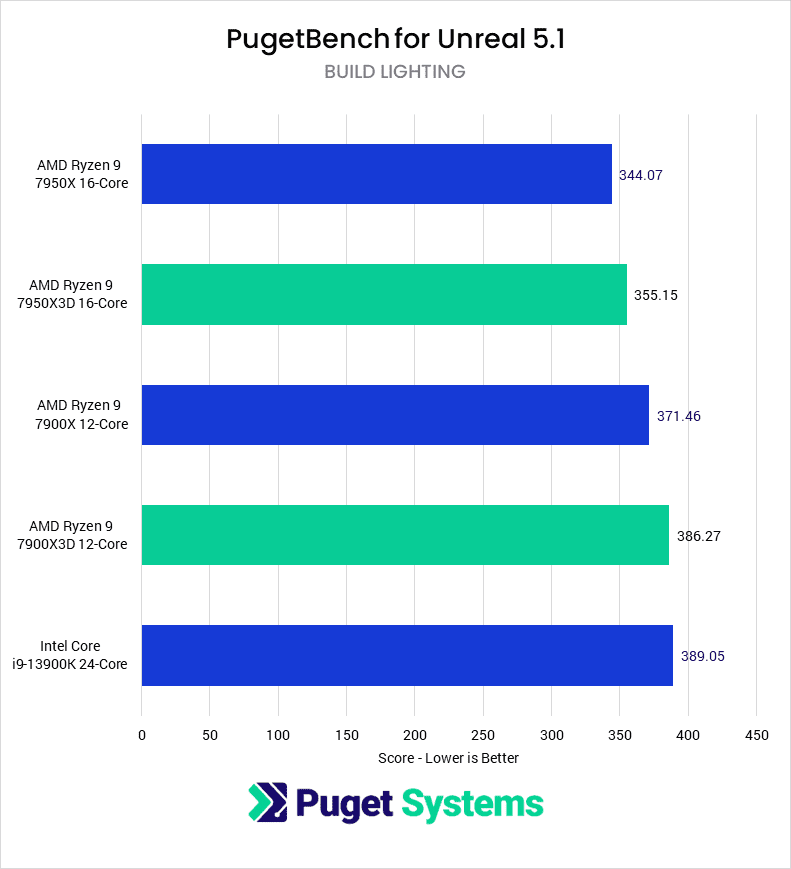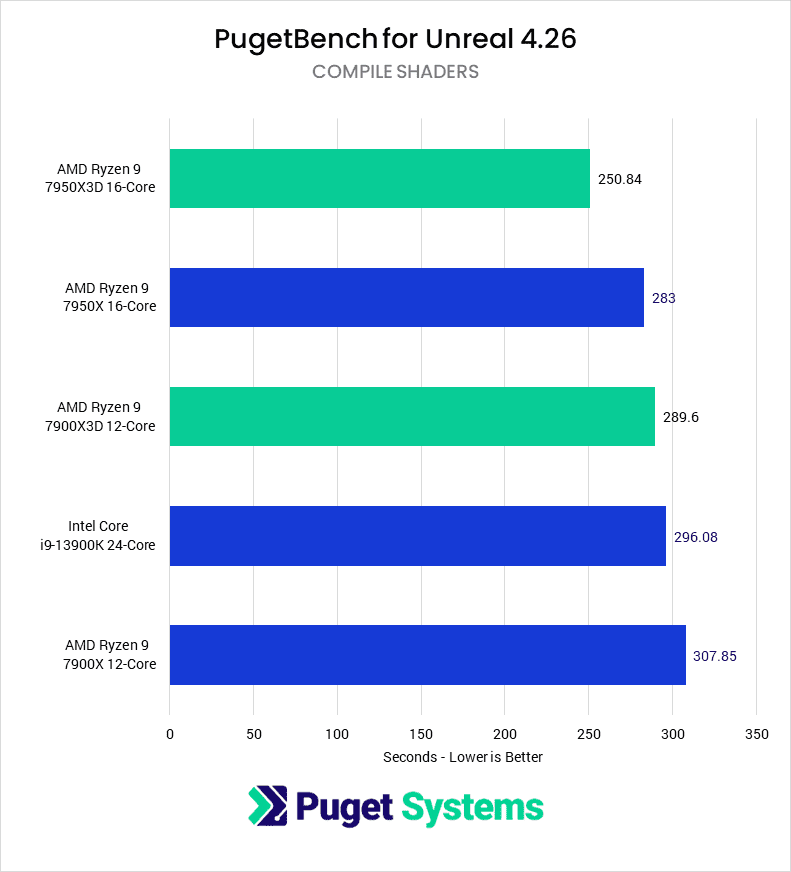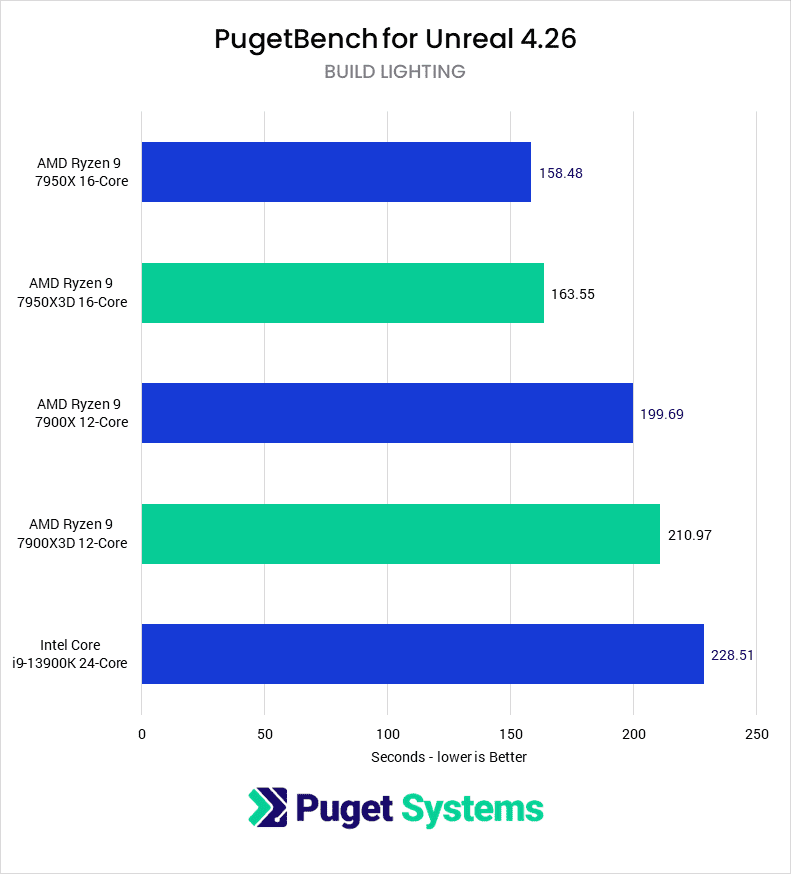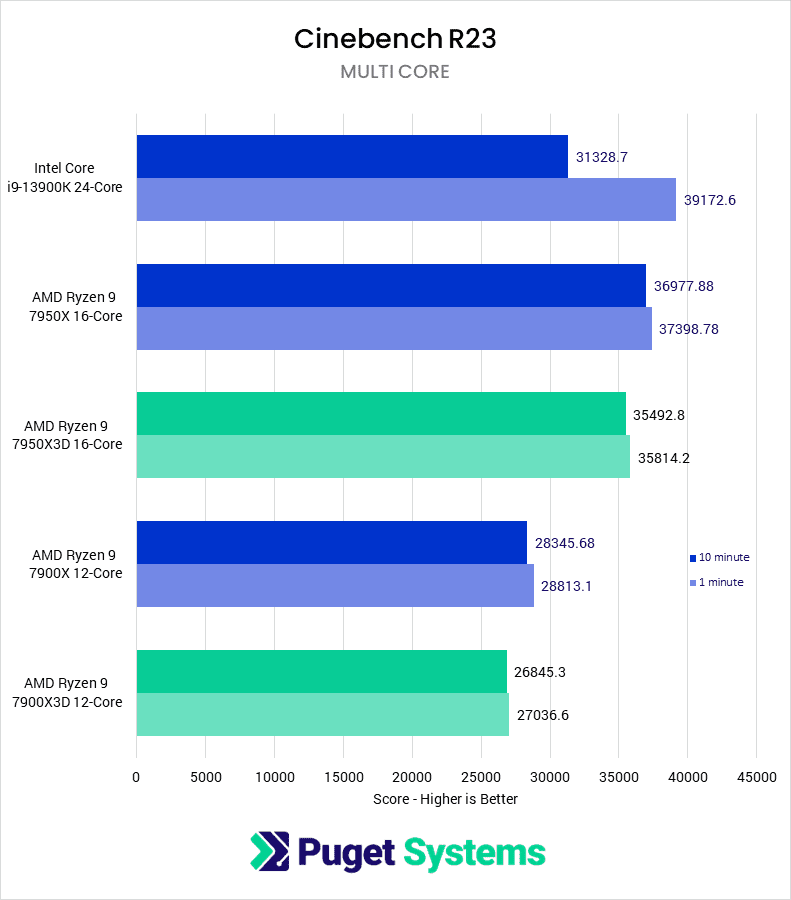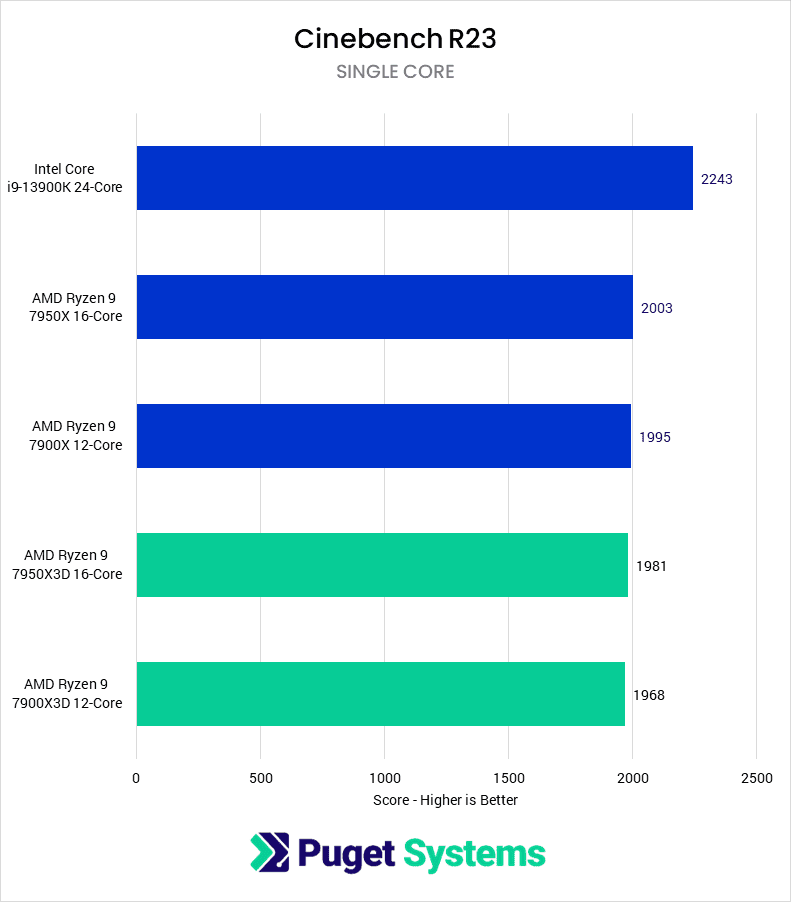Table of Contents
TL;DR: AMD Ryzen 7000X3D vs 7000X Series for Content Creation
The 7000X3D series processors have been stated by AMD to be designed for incredible performance for gamers and creators, a distinct change from their previous generation Ryzen 7 5800X3D which focused wholly on gaming. This new line of 3D V-Cache processors now features 12- and 16-core variants and does not have a reduced maximum boost clock.
Our testing found that while the AMD Ryzen 7000X3D CPUs perform slightly worse than their non-3D counterparts in most content creation workflows, they, in turn, draw noticeably less power. Although an overall improvement as compared to the 5800X3D’s performance in content creation their current price premium makes the 7000X models an overall better value in most cases. If your primary use case for the system is content creation, we recommend sticking with the AMD Ryzen 9 7950X, 7900X, or the Intel Core i9 13900K.
The Ryzen 7950X3D and 7900X3D may also have an interesting use case if you care about thermals, noise, or power draw as they operate noticeably cooler than the Ryzen 7950X and 7900X while consuming nearly 30% less power. The success of these processors for content creation, though, ultimately depends on the relative pricing between them and their Ryzen 7000X counterparts.
Introduction
The new Ryzen 7000X3D line of CPUs is AMD’s latest iteration of processors that aims to cater to the demands of creators and gamers by combining their high-end desktop CPUs with additional L3 Cache through their AMD 3D V-Cache Technology.
When we reviewed the last AMD 3D V-Cache CPU – the 5800X3D – we found that the CPU was worse overall than the 5800X for content creation, likely due to the lower clock speeds on the 5800X3D. This, paired with them only releasing the 3D V-Cache technology on the 8-core model, meant we had a cool take on the technology for content creation purposes. However, with the release of the Ryzen 7000X3D product line, AMD has expanded their 3D V-Cache offerings to include 8-, 12-, and 16-core variants.
AMD’s marketing has also shifted, with the Ryzen 7000 variants being touted as “the ultimate processors for both gamers and creators“; the 5800X3D lacked any mention of non-gaming performance on its product page. With AMD marketing directly for creators, we expect content creation performance to be much improved compared to the previous X3D model.
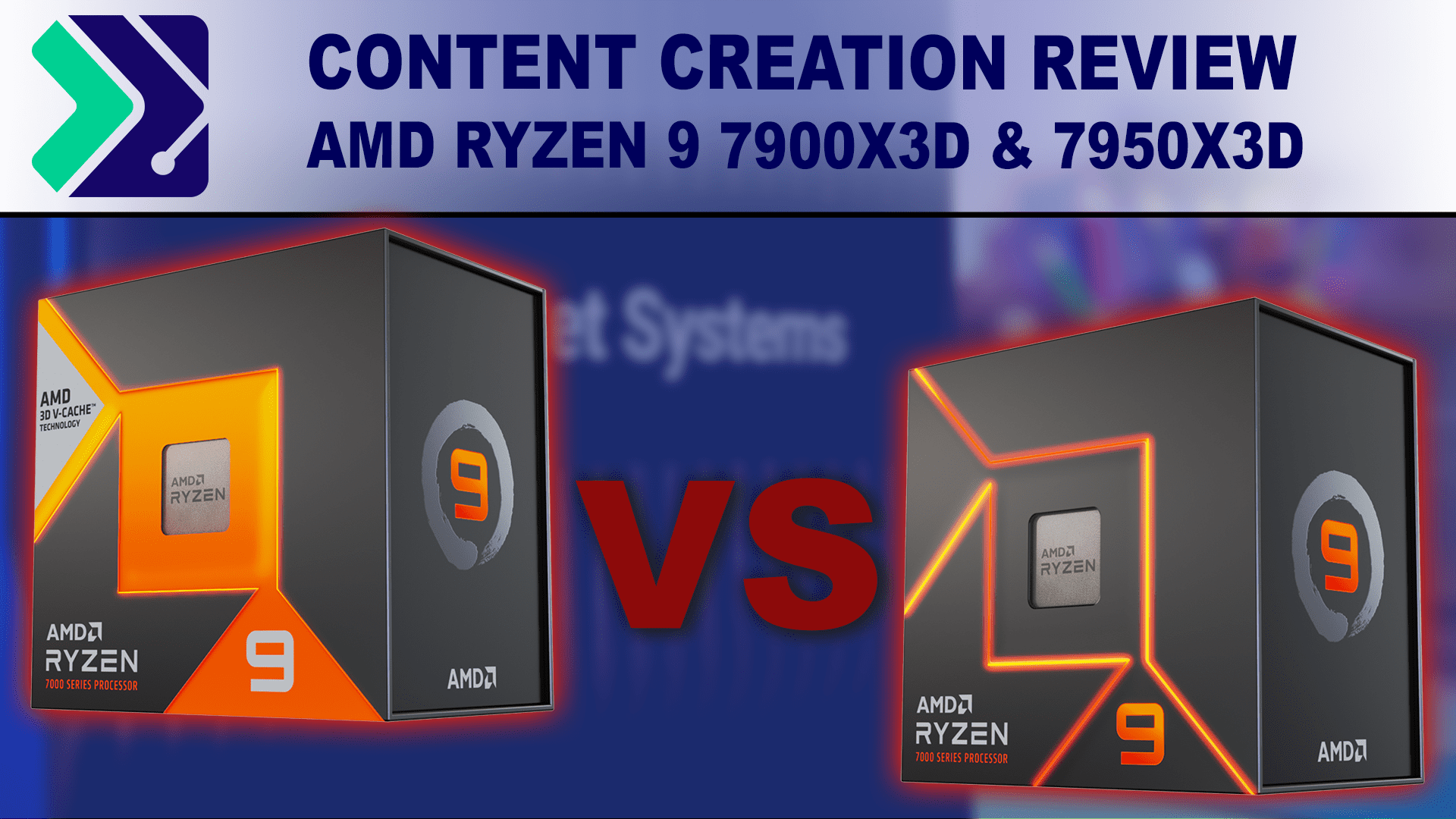
The new AMD Ryzen 7000X3D CPUs are modeled on the AMD Ryzen 7000X series CPUs released in September of last year. Although AMD has three variants of Ryzen 7000 processors with 3D V-Cache technology, we will only be reviewing the two highest-end models as we typically recommend at least the AMD Ryzen 7900X for content creation.
| CPU Model | MSRP (Sale) | Cores / Threads | L3 Cache | Base Clock | Boost Clock | TDP (Max) |
|---|---|---|---|---|---|---|
| AMD Ryzen 9 7900X | $549 ($449) | 12 / 24 | 64MB | 4.7 GHz | Up to 5.6 GHz | 170W |
| Intel Core i9 13900K | $589 | 24 / 32 | 36MB | 3.0 GHz | Up to 5.8 GHz | 125W (253W) |
| AMD Ryzen 9 7900X3D | $599 | 12 / 24 | 128MB | 4.4 GHz | Up to 5.6 GHz | 120W |
| AMD Ryzen 9 7950X | $699 ($599) | 16 / 32 | 64MB | 4.5 GHz | Up to 5.7 GHz | 170W |
| AMD Ryzen 9 7950X3D | $699 | 16 / 32 | 128MB | 4.2 GHz | Up to 5.7 GHz | 120W |
Looking at the Ryzen CPUs, the X3D models are priced relatively close to their non-3D counterparts and, based on MSRP, you are looking at the same cost for the 7950X3D or a $50 premium for the 7900X3D. However, pricing changes often, and AMD has been offering what looks like a permanent sale on the “X” models, dropping them around $100-150 below their X3D counterparts.
However, this is clearly marked as a sale on AMD’s store, so it is unknown if the price of the “X” models will jump back up; we have reached out to AMD for comment and will provide an update if we get confirmation. We typically do our evaluations using the published MSRP for each product, but since we suspect this may be a more permanent pricing adjustment, we will look at the value in both contexts.
In terms of specifications, the Ryzen 9 7900/79050X3D processors feature twice the L3 Cache of the Ryzen 9 7900/7950X processors alongside a lower base clock, TDP, and max operating temperature. Though not featured in this review, the Ryzen 7 7800X3D deviates from these in that it has a slight increase in TDP alongside the extra 64MB of L3 Cache compared to the 7700X, though it has a similar decrease in max operating temperature and base/boost clock.
Test Setup
AMD Ryzen 7000 Test Platform
| CPUs: AMD Ryzen 9 7950X3D 16-core AMD Ryzen 9 7950X 16-core AMD Ryzen 9 7900X3D 12-core AMD Ryzen 9 7900X 12-core |
| CPU Cooler: Noctua NH-U12A |
| Motherboard: ASUS ProArt X670E-Creator WiFi |
| RAM: 2x DDR5-4800 32GB (64GB total) |
| GPU: NVIDIA GeForce RTX 4080 16GB |
| PSU: Super Flower LEADEX Platinum 1600W |
| Storage: Samsung 980 Pro 2TB |
| OS: Windows 11 Pro 64-bit (22621) |
Intel Core i9 Test Platform
| CPUs: Intel Core i9 13900K 24-core |
| CPU Cooler: Noctua NH-U12A |
| Motherboard: ASUS ProArt Z690-Creator WiFi |
| RAM: 2x DDR5-4800 32GB (64GB total) |
| GPU: NVIDIA GeForce RTX 4080 16GB |
| PSU: Super Flower LEADEX Platinum 1600W |
| Storage: Samsung 980 Pro 2TB |
| OS: Windows 11 Pro 64-bit (22621) |
Benchmark Software
| Photoshop 24.1.1 – PugetBench for Photoshop 0.93.6 |
| Lightroom Classic 12.3 – PugetBench for Lightroom Classic 0.94 |
| After Effects 23.3 – PugetBench for After Effects 0.95.6 |
| Premiere Pro 23.3.0 – PugetBench for Premiere Pro 0.95.6 |
| DaVinci Resolve 18.1.4 – PugetBench for DaVinci Resolve 0.93.2 |
| Unreal Engine 4.26 |
| Unreal Engine 5.1 |
| Cinebench R23.2 |
| Blender 3.4.0 |
| V-Ray 5.02.00 |
For this article, we will focus on AMD’s Ryzen 9 X3D processors. The 7800X3D is also a very interesting CPU, but the higher 12- and 16-core processors are much faster for professional content creation workflows. As a comparison, we will be using the standard “X” variants of these CPUs (the 7900X and 7950X) and will also include the Intel Core i9-13900K to see how Intel stacks up.
As we look at this from a workstation standpoint, we will test all of our systems according to Intel and AMD’s official specifications; we enforce manufacturer power and boost duration limits where applicable and disable performance-boosting technologies that operate the processor outside of manufacturer specifications. These include Precision Boost Overdrive for AMD and Multi-Core Enhancement on our Intel motherboards. Although we do not expect it to affect our testing due to these guidelines, we are running BIOS version 1410, which enforces an SoC voltage of 1.30V on our ASUS ProArt X670E-Creator WiFi motherboards. This addresses a voltage setting issue some users experienced when running Ryzen 7000X3D CPUs with overclocked memory that could result in damaged components.
We will test with our standard content creation suite, including many of our Puget Systems Benchmarks, on the latest versions of their host applications. Many of these include the option to upload results to our online database, and if you want to know how your system compares, you can download and run the benchmark yourself. We will also test with our in-progress Unreal Engine benchmark – on Unreal versions 4.26 and 5.1 – and a few other CPU-based rendering engines.
CPU Power Consumption and Temperatures
One area we have recently begun looking at more is CPU power consumption during benchmarks. Although most of our customers are less concerned about system power draw than performance, it is interesting to see how processors use the power available to them. Additionally, this allows us to ensure that processors are running in-spec and that we are using sufficient cooling for our processors.
We will start by looking at the CPU Package Power Consumption in several workloads for our tested processors. We are looking at CineBench, a high-intensity multi-core workload; Photoshop, a low-intensity workload; and Unreal Engine 4.26, where we will see some of the most exciting performance results in our testing.
For the power consumption analysis, we are calculating the Watt-hours of energy used during the benchmark run. This accounts for the power draw of a particular CPU while adjusting for the time taken to complete the benchmark, although all of our CineBench benchmarks run for the same duration.
In most cases, the Ryzen 7950X3D and 7900X3D each use about 30% the energy to complete the benchmarks than their non-3D counterparts, which is an impressive reduction in power draw for what is, we’ll see, a small overall decrease in performance. These CPUs are very efficient when ran at manufacturer specifications.
We are also examining both the average and max temperatures for the processors as many of our benchmarks can cause intermittent spikes which elevate maximum recorded temperatures. For context, the X3D processors have a maximum temperature of 89 degrees Celsius to the 7000X series’ 95 degrees Celsius. Although all of these CPUs can reach their maximum temperature during the CineBench run, the 7000X3D processors stay under 89 degrees Celsius in both Photoshop and Unreal 4.26.
AMD’s latest generation of Ryzen processors are designed to operate up to and at their maximum temperature for sustained periods of time when boosting properly, so we are not concerned about those CPUs hitting maximum temperature at least once on one core during some of the benchmarks. That the average temperatures are all well below the maximum temperature tells us that our CPUs are staying adequately cooled. The X3D CPUs also maintained an average temperature of about 5 degrees Celsius under the non-X3D CPUs with our setup.
Overall, the Ryzen 7000X3D series processors offer an advantage in thermals and power consumption over their non-3D counterparts and may be a good option if those are areas of major concern.
Video Editing: DaVinci Resolve Studio
Starting off our performance analysis, we are going to take a look at DaVinci Resolve Studio. This application is known in the industry for how well it takes advantage of high-performance GPUs, but the CPU is still critical throughout the application.
In terms of overall performance, the 7900X and 7900X3D scores are within about a percent of each other, although the 7950X is a measurable 6% faster than the 7950X3D. In most of the workflows we look at (performance for LongGOP, Intraframe, and RAW codecs), performance for the current “X” and new “X3D” models is virtually identical. The only area that shows a significant difference are the Fusion tests, used in the motion graphics and VFX portions of Resolve.
Here, the Ryzen 7950X, in particular, is much faster than the new Ryzen 7950X3D model – about 13%. This isn’t an earth-shattering difference for most users, but it does mean that from a pure price/performance standpoint, the new X3D models aren’t a particularly great fit for DaVinci Resolve; You also aren’t going to be giving up too much if you want to use them for something like gaming, with some video editing in Resolve on the side.
Video Editing: Adobe Premiere Pro
Moving on to Adobe Premiere Pro, the CPU can make a much more significant impact on performance than it does in DaVinci Resolve. The difference between the “X” Ryzen CPUs and the new “X3D” models is even smaller in this case. Overall, you are looking at only a 1-2% difference, which is well within the margin of error for this type of test, and the largest single difference was only about 5% – which isn’t enough to matter for any real-world workflow.
Motion Graphics: After Effects
Adobe After Effects is much the same as Premiere Pro. No significant performance difference between the Ryzen 7900X/7900X3D or the Ryzen 7950X/7950X3D. The new X3D models are not any slower but also don’t provide any tangible performance benefit.
Graphic Design: Photoshop
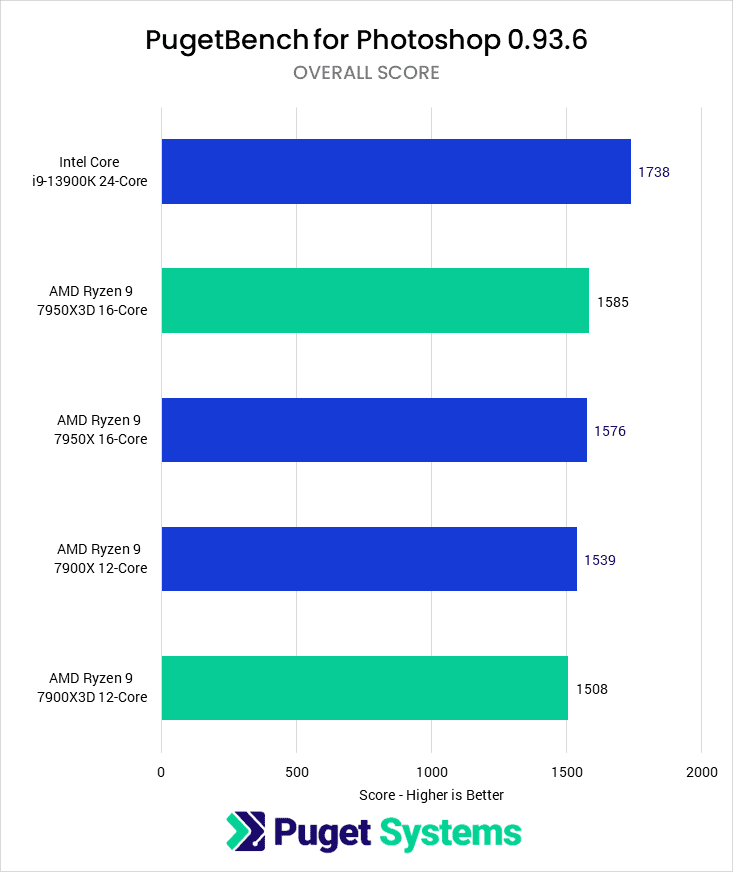
We are repeating ourselves at this point, but Photoshop is yet another instance where the X3D models are no better – or worse – than the standard “X” models.
Photography: Lightroom Classic
Adobe Lightroom Classic sometimes throws us a curveball when it comes to the performance from different CPUs, but not this time. Instead, just like Photoshop and Premiere Pro, there is no significant difference in performance between the “X” and “X3D” models.
Game Dev/Virtual Production: Unreal Engine
Unreal Engine provides us with one use case that favors the new X3D CPUs. Specifically, compiling shaders is much faster with these new processors. With Unreal 4.26, they are about 12% faster, and with Unreal 5.1, they are almost 18% faster. This makes sense because compiling shaders is essentially reading, compiling, and writing several thousand mini-programs, so there is a lot of data going into and out of the cache.
Building lighting is a different story. Here the new CPUs are a few percent slower than the older processors. This task has a lot in common with CPU rendering, where we also saw a slight drop in performance. This isn’t a super common task, so the improvement in compiling shaders will outweigh the small differences in lighting.
CPU Rendering: Cinebench
Moving on to CPU rendering, we see the same results that we have been seeing for most of our testing thus far. Using Maxon’s Cinebenche R23 the X3D variants are just slightly slower than the non-X3D parts by roughly 4%. This is likely due to the lower clock speeds and power draw, but this class of CPU isn’t the go-to option for CPU rendering anyway. 3D modeling and animation users looking for high single-core performance, who only occasionally use CPU rendering, may be willing to trade a slightly slower render for the lower power consumption.
CPU Rendering: V-Ray
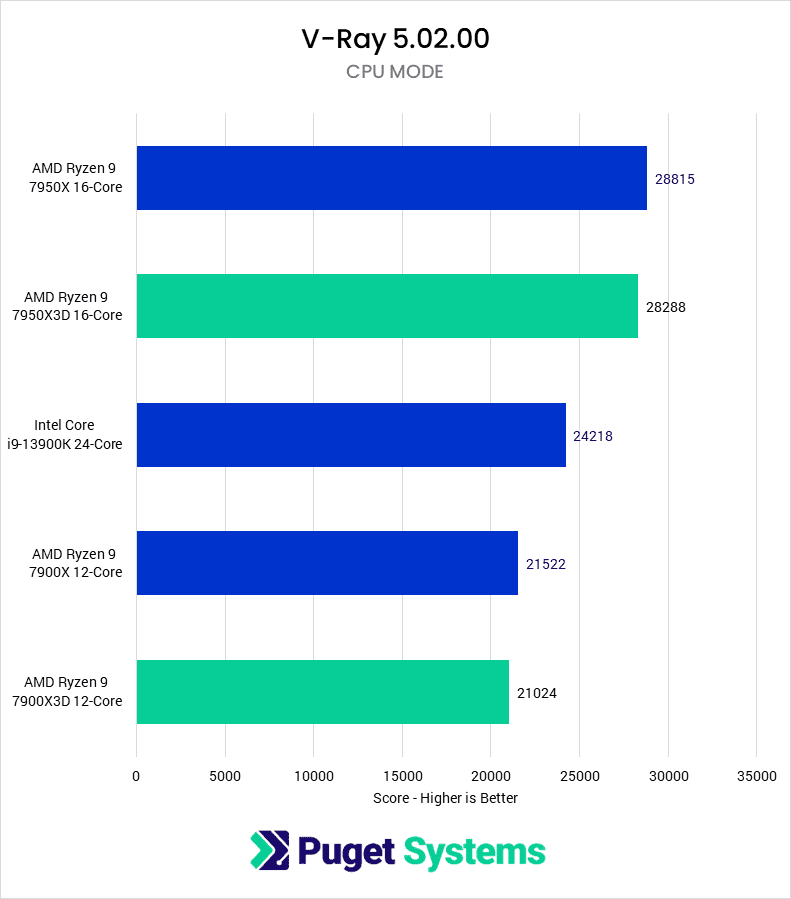
V-Ray from Chaos has a similar conclusion: The new Ryzen 7000X3D CPUs are roughly 2% slower than the existing processors. V-Ray’s scores are very consistent, but this could still be considered within the margin of error.
CPU Rendering: Blender
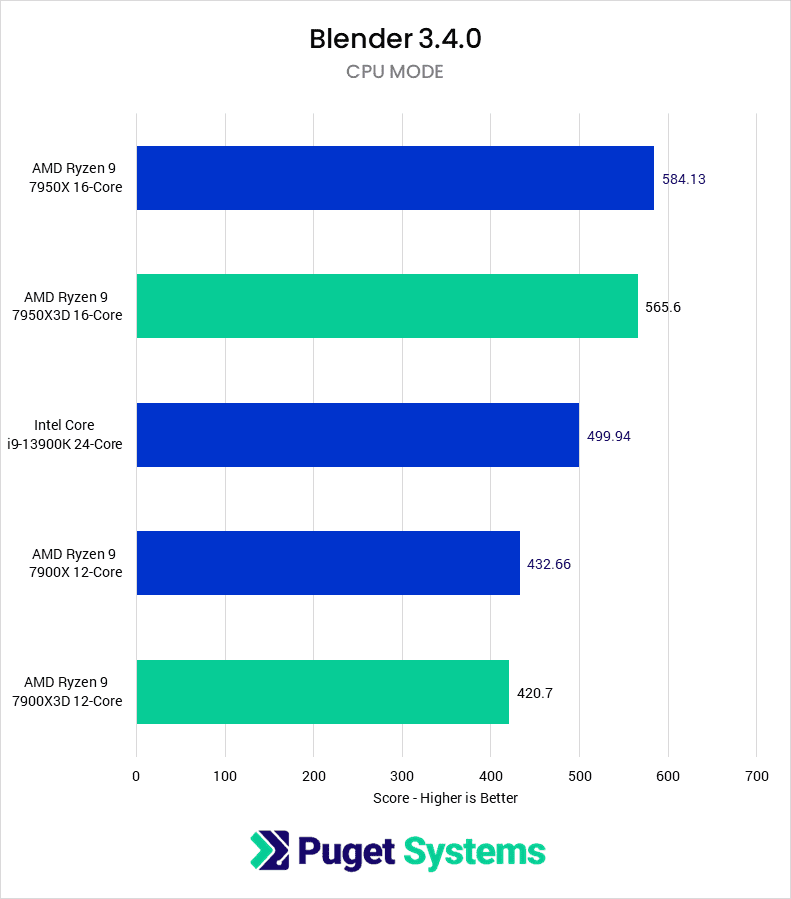
Blender is our newest rendering benchmark. Most users have moved over to GPU rendering, but rendering on the CPU still has its advantages. As we saw in the other rendering packages, the new X3D CPUs are slightly slower, this time by about 3%.
How Well Do the AMD Ryzen 7900X3D and 7950X3D Processors Perform for Content Creation?
AMD presented these new 3D V-Cache processors as having “extreme performance for gaming, creating, streaming, or whatever workload” – notable compared to the 5800X3D, which made no such claims about performance outside gaming. True to their claims, these processors do not suffer many of the performance drops we saw from the last generation of this technology, leaving them largely on par with their non-3D counterparts for content creation; however, there are several applications, primarily CPU rendering, where they still fall behind slightly. If content creation is your primary use for your computer, we still recommend the Ryzen 9 7950X, Ryzen 9 7900X, or the Intel 13900K, depending on your primary applications.
Breaking down by industry, for Photography and Motion Graphics/VFX, the Ryzen 7000X3D series processors saw little performance difference from the Ryzen 7000X series. Similarly, video editing only showed notable results in DaVinci Resolve, where the 7950X3D was about 13% slower than the 7950X in the Fusion scores. For these industries, the 7000X series are either on par or faster and at what may be a lower price.
Building Shaders in Unreal Engine was one of the few areas of significant performance improvement for the X3D models. This is not typically a daily task – let alone more frequent – so the value of reduced Shader Compilation times will differ for everyone. Light baking, on the other hand, had no notable performance improvement.
CPU rendering saw very little difference between the X3D CPUs and the non-X3D versions, with a slight edge to the non-X3D processors. There was also no difference in single-core performance, so they aren’t helpful to modeling and animation workflows.
The primary area where we found a notable difference between the 3D V-Cache processors was in thermals and power draw, where the X3D CPUs used around 30% less power and remained around 5-10 degrees Celsius cooler on our test benches. Although not always major concerns for most workstation users, if power draw, temperature, or noise are driving factors in part selection, these processors may be a good choice. One area we may investigate in the future is whether limiting the 7000X CPUs to similar TDPs would achieve the same results – though the usefulness of this will depend wholly on the cost difference between the two varieties of processors.
The elephant in the room around these new processors is ultimately how much you can buy them, or their non-3D counterparts, for. If AMD’s current “sale” price for the 7000X CPUs isn’t a permanent pricing adjustment and the X3D CPUs end up within $50 of the X models, then the 7900X3D and 7950X3D offer an interesting alternative for many of the workflows we tested. Overall similar price and performance at a much-reduced power draw.
However, if the sale price is a perpetual MSRP change, as we have seen with past AMD processors, the X3D models are not as attractive for these workflows. At current sale pricing, the Ryzen 7950X costs the same amount as a 7900X3D while delivering higher performance in most applications. The 7950X3D and 7900X3D may be worth the investment if you are looking to build as quiet of a system as possible at their given performance, but the 7950X and 7900X are better options from a price-to-performance perspective.
As we mentioned earlier in this article, we have reached out to AMD for clarification on whether the sale price is temporary and will add a note to this article when we get word back. Regardless, for someone who uses their machine both for gaming and content creation, the X3D CPUs should be terrific. Whether we will offer them in our workstations, however, will depend heavily on whether the Ryzen 9 7950X and Ryzen 9 7900X return to their MSRP.
If you are in need of a workstation for any of the applications we tested, we’ve got you covered. Our solutions page offers a curated selection of recommended workstations ideal for various software packages. If you prefer a more customized approach, our custom configuration page allows you to build a workstation tailored precisely to your requirements. Need assistance in configuring a workstation that suits your unique workflow? Reach out to our technology consultants, who are ready to lend a hand.





